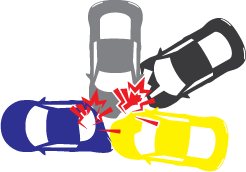Since the mid-1970s, California has adhered to the rules of “comparative negligence” when determining who is at fault for auto accidents and multi-car accidents in Woodland Hills when more than one party may be to blame.
What is “Comparative Negligence”?
When a driver’s negligence (texting and driving, falling asleep at the wheel, speeding) causes a car accident, California law assigns blame to the at-fault driver (the defendant) and the victim (the plaintiff) is allowed to recover financial damages associated with the accident from the defendant.
What happens, however, when the plaintiff is partially responsible for causing the accident? The situation gets a bit more complex and speaking with an experienced personal injury attorney in Woodland Hills may be necessary.
Under the theory of comparative negligence, a plaintiff may sue for the percentage of damages attributable to the defendant. If a party is partially responsible for causing an accident, California law says the amount of their recovery should be reduced in accordance with their level of fault.
For instance, if Motorist X is 40% responsible for a crash, while Motorist Y is 60% responsible, X can still recover damages against Y, but the amount of X’s financial damages would be reduced be by 40%.
Similarly, if X were 99% responsible for an accident, while Y is 1% responsible. Y could recover damages against X, but Y’s award would still be reduced by 1% to account for his or her level of fault.
Can I Sue the Other Driver Even If I Was At Fault?
In a Woodland Hills car accident, each defendant is only liable for his or her percentage of fault. If you were injured by another driver’s negligence, you may still be able to recover damages, even if you were at fault in contributing to the accident. The ultimate award of damages for any plaintiff in a car accident case will be reduced by his or her own percentage of fault.
The rules for comparative negligence are codified in California Civil Code 1431.2, which states that “Each defendant shall be liable only for the amount of non-economic damages allocated to that defendant in direct proportion to that defendant’s percentage of fault, and a separate judgment shall be rendered against that defendant for that amount.” (“Non-economic” damages refers to “subjective, non-monetary losses including, but not limited to, pain, suffering, inconvenience, mental suffering, emotional distress, loss of society and companionship, loss of consortium, injury to reputation and humiliation”.)
If you are the victim of an accident caused by someone’s negligence, be sure to speak to a successful personal injury attorney in Woodland Hills. Even if you may be partially at fault, you may be entitled to a recover financial compensation for your injuries. To learn more, or to discuss your potential case, contact Woodland Hills auto accident attorney Barry P. Goldberg today.







